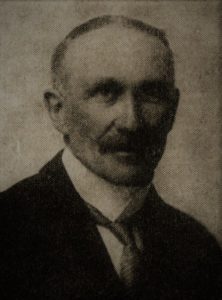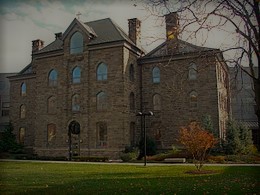
Rev. Friðrik Bergmann Photo: SÍN
Friðrik Jónsson Bergmann: He studied Theology in St. Louis, Missouri, Oslo, Norway, and Philadelphia from where he was ordained as pastor in the spring of 1886. He accepted a call from Icelanders in North Dakota the same year and served there until 1902. He moved to Winnipeg and took up teaching at Wesley College and served an Icelandic congregation (Tjaldbúðarsöfnuði) in the city. He became Vice-President of The Evangelical Lutheran Icelandic Church in North America but resigned in 1909 due to theological disagreements. He was a very enthusiastic writer, editor and publisher and numerous books and articles of his were published. He was editor of Aldamót 1891-1903 and Breiðablik 1906-1914. He edited and published Eina Líf in 1899, Ísland um aldamótin, Reykjavík, 1901, Ísland hið unga, Winnipeg 1903, Vafurlogar in 1906, Treginn og tárin, Reykjavík 1911, Hvert stefnir, Winnipeg 1916, Tvær prédikanir (co-author Rev. Jón Bjarnason), Reykjavík 1891, Fyrirlestrar (The Lutheran Icelandic Church) 1899 and Sögur Breiðablika, Winnipeg, 1919. Þórstína Þorleifsdóttir was a student of Rev. Friðrik in N. Dakota and mentions him in her book, “Saga Íslendinga í N. Dakota” published in Winnipeg in 1926.

The Lutheran Theological Seminary in Philadelphia Photo: LTSP
Rev. Friðrik J. Bergmann: In 1886 Rev. Hans Thorgrimsen accepted a call from Norwegians in S. Dakota. That same year, Rev. Friðrik J. Bergmann had graduated from the Theological Seminary in Philadelphia. Friðrik J. Bergmann from Syðra-Laugaland in Eyjafjörður, son of Jón Jónasson, Sigfússon Bergmann from Garðsvík on Svalbarðsströnd and Halldóra Bessadóttir from Gautsstaðir in same county, was called as Rev. Hans’ replacement in N. Dakota from his congregations there as well as one additional. In total, he served 8 congregations during 1886-1893 and in one, the Vídalín congregation, he preached in two different locations. There were 36 miles from his home to Grafton, 55 to Pembina, north to Tongue River, and up to Fjalla 20 miles. He travelled all these distances in an open wagon regardless of weather conditions. Rev. Friðrik’s task as religious leader was invaluable. Young and full of spiritual and physical energy, he arrived in the colony, having been inspired by the culture in eastern United States and for two years in Norway. He was an outstanding, devoted leader, not only as preacher and cultural inspiration but also as teacher and writer. He was very modest, always a good listener, pleasant and always strove for the progress of his fellow countrymen. In 1902 Rev. Friðrik left Dakota to become a teacher of the Icelandic language at the Wesley College in Winnipeg, a position sponsored by the Icelandic Church Association for 8 years. She, who here holds the pen, has wonderful memories of Rev. Friðrik as a teacher. He managed in an extraordinary way to awaken his pupils’ interest in the Icelandic heritage so interwoven in Icelandic literature and stimulate respect and understanding of the Icelandic nationality which must be protected. Rev. Friðrik’s life, dedication and sacrifices during his early years in the community leaves a lasting feeling in the hearts of all the pioneers. The following quotation from the minutes of meeting of the Vídalín congregation, January 15, 1893, when Rev. Jónas S. Sigurðsson had just been called describes his personality and modesty: “Next Rev. Friðrik was asked what he was charging for all his efforts. He responded by saying he had not thought of payment for his work, he accepted nothing, continued saying men need to give their all to the tasks they had committed to and if they were successful, he was very grateful. He concluded with a wish, that true co-operation would be blessed between congregations and pastor. The Chairman thanked the Rev. Friðrik in few words for his remarkable work for the congregation in the past as well as for what he had just done.” Pétur Pálmason, secretary.” (English version J. Th)
Rev. Friðrik J. Bergmann in Iceland in 1899: He and Stephan G. Stephansson were contemporaries and were acquainted but had different views in religious and cultural matters. Stephan memorialized Rev. Friðrik in a poem in 1918 after his death. In his notes to the publisher of his poetry Stephan writes: “He [Rev. Friðrik] and the author [Stephan] briefly met in Iceland, teenagers then. In the West they were in Wisconsin and N. Dakota at the same time, always acquainted but opponents in various matters early on. But both grew out of that. And in the poem itself, this is touched on, when he states that all their differences and what they shared remained in the past as they made peace in their early years.” ( English version J. Th) Rev. Friðrik visited Iceland in 1899 with his colleague Rev. Jón Bjarnason, who also was a serving pastor in the west. The companions visited numerous places, sailed from Reykjavík north and east to Akureyri. From there they rode back south to Reykjavík, visiting many places during that journey. After a few days rest there they started a week-long journey in the beginning of September, riding eastward along the south coast. The main purpose of that tour was to visit the hymn poet Rev. Valdemar Briem at Stóra-Núpi. Everywhere they visited in Iceland they were well received, in particular by members of the Icelandic church. Rev. Friðrik conducted church services in numerous places and made note of the number of Icelandic pastors attending each service. Rev. Friðrik considers Icelandic issues both spiritual and worldly with fatherly critical eyes, compares some with what he is accustomed to in America, and he is somewhat opinionated. Now let us consider his own words (English version J. Th): “It does not require keen eyes to notice the steady decline in church attendance in Iceland in the last 25-30 years. Unfortunately, it is not adequate in the villages where attending church is easiest. There, horse riding on Sundays has become such a sport and despite efforts to start bright and early in the morning.” Although the pastor has his views on the Icelandic roads, he feels people in the country should use wagons more than they do, he certainly appreciates the qualities of a well-bred, Icelandic horse. When he visits Skagaströnd, where every pastor meets him with open arms he says: “Rev. Hallgrímur Thorlacious is a keen rider, owns a few quality horses himself which I had the pleasure of riding, one after the other. The same pleasing feeling which fills the heart of every Icelander once mounted affected me in the same manner. The Icelandic horse is such an admirable animal, one can say, made for the land. Life there would be unbearable if the horses were not there to fill every rider with such joy, happiness. The famous polar explorer Dr. F. Nansen maintains that the Icelandic horse is the best mountain horse in the World, which is probably true. If every countryman approached his duties in a similar fashion, life would certainly be great. The Skagafjörður breed is by far better than most I tried, such a smooth, effortless ride, it almost feels like sitting in your most comfortable chair at home. However, I did not find them lasting long, almost out of breath too soon, probably due to inadequate training”.
One can say the pastor studies the culture and life in general making a very interesting report and interesting reading. Let us briefly consider his thoughts on communication and roads in 1899, just about 4 years prior to the first touch of the wheels of Thomson’s car on Icelandic soil. “The road from Reykjavík eastward across Hellisheiði runs all the way to Eyrarbakki and east to Þjórsá is a magnificent accomplishment, an excellent road. Sitting in a wagon pulled by well-trained horses would be such a pleasure. This by far is the longest road made in Iceland, a pride to all in the country and hopefully more such roads will be made all over the island before another quarter of a century has passed. Another road from Reykjavík crosses over Mosfellsheiði to Þingvellir. Aside from those two, only short roads here and there can be found on the island. Outside Reykjavík, signs along the road reminds riders to water their horses, Tryggvi Gunnarsson was believed to have arranged that, a wonderful token of growing concern for the well-being of animals. West on Hellisheiði is a resting place called Kolviðarhóll. It is a new farm, built in part with financial support of the National Fund. The farmer, living there, receives annually a small amount as this is a remote place, no other farm in sight and pastureland small. Travelers are supposed to rest here for a while, get refreshment for themselves as well as for their horses. We had heard in Reykjavík, that some unbelievable faults could be found on and beside those roads, for instance men got more tired riding along them than on other roads. We did not pay attention to such rumors, were convinced this was just typical Icelandic hearsay as our fellow countrymen tend to be overly disappointed with something they have longed for so long, once they get it. However, we discovered this was not hearsay at all. The new roads were hard as rock as they had to last. So, each step taken on those feels like a step on solid rock. The ride is not as smooth on the new roads as on the old paths so there is no doubt the rider gets more tired. Some say the horses will not last as long on the new roads, their legs eventually become permanently weak. All good things have certain limits. This should result in increasing interest in travel in wagons as is done in many places elsewhere in the world. Otherwise, it is waste of money to build such roads. You cannot place up to 12 individuals onto a wagon, expecting the small Icelandic horses to pull such a load, as I have heard has been done once, resulting in the horses giving up halfway to the destination. But lightweight American wagons for two persons will easily be managed with ease for long journeys; people would soon realize how much more comfortable such a journey is, when one sits straight as in one’s best easy chair in the living room at home. But this idea has yet to sink in in Iceland. On the last travel day in the year, the pastor at Þingvellir rode to Reykjavík, accompanied by a group of friends who rode out to meet him and had a feast at Valhöll. This was on Sunday, September 10 and …as we approached the capital city, we noticed a large number of riders many of whom were visibly drunk. All around Reykjavík, small, friendly huts have been built where wine is sold by the glass mostly on Sundays. But in the city drunkenness was hardly noticed, certainly a change from the past when there was no authority to control people, and it was considered heroic to be visibly drunk.
English Version by Thor group
